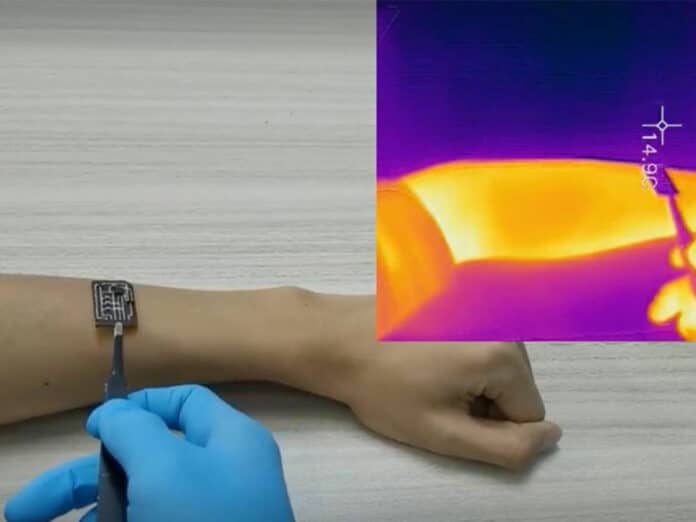Researchers have developed an improved medical sensor capable of responding to changes in temperature, adapting to the skin, and even self-healing. This cutting-edge technology promises to revolutionize the field of medical sensors, improving their reliability and accuracy and ultimately benefiting patients.
Researchers at Penn State have developed sensors for wearable electronics that can transform from rigid to soft and heal their wear and tear. The team, led by Hyanyu “Larry” Cheng, used liquid metal and specialized polymers to create sensors that can conform to the skin’s topography, improving the accuracy of vital information gathered. While manufacturing sensors in a rigid state are better for layering and display purposes, being in a peaceful state while worn allows for greater comfort and accuracy. The study was published in Advanced Materials.
“In the past, we have to use two types of devices because we didn’t have a way to get these two married together,” Cheng said. “But now, we prove that switching a sensor from rigid to soft can be modulated by a simple temperature switch. When the sensor is skin temperature, it is soft, but when it is very cold, it will become rigid again.”
The soft state also means that the sensors can be more easily removed without damaging the skin, which is especially important for infants and the elderly.
Researchers have developed medical electronic sensors that use temperature changes to alter the state of liquid metal, allowing for flexibility in design and self-healing properties. This approach can be achieved at a temperature relevant to the human body and could restore the function of sensors in almost no seconds. The researchers plan to integrate this technology into sensors at scale for use in various settings, from nursing homes to disease-progression monitoring. Multiple organizations, including the National Natural Science Foundation of China and the National Science Foundation, supported the work.
Flexible electronic devices have unique properties that make them useful in soft robots, flexible sensors, and flexible printed circuit boards. These devices can monitor vital physiological data for early disease diagnostics and human-computer interfaces. However, they are susceptible to mechanical damage and failure, so self-healing materials have been used to create self-healing biosensors, supercapacitors, batteries, and triboelectric nanogenerators.
A new self-healing, thermal-switching, transformative multifunctional electronic device platform has been introduced based on printable biphasic Ga–In (bGaIn) and self-healing hygroscopic randomly hyperbranched polymers (HRHP). The HRHP electronics can conveniently switch between rigid and soft modes by temperature to exhibit variable stiffness for versatile applications. The COTS components and bGaIn circuits can also be recycled with an ethanol solution for reuse.
The experiment demonstrated the successful use of thermal switching and self-healing properties in medical electronic sensors using liquid metal and a type of polymer with hydrogen bonding. The service of these properties allows for alteration of the state of the material at a temperature relevant to the human body and self-healing of mechanical damage, allowing for uninterrupted monitoring and extending device life.
The researchers achieved faster healing times than previous work, with the potential for restoration of function in almost no time. The next step is to integrate these properties into sensors at scale for use in various settings for health monitoring, such as nursing homes and disease-progression monitoring.
The improved medical sensor is temperature-responsive, which means it can detect even subtle changes in temperature and respond accordingly. This is particularly useful in medical applications, where temperature changes can indicate various health conditions.
Furthermore, the sensor is designed to adapt to the skin, an essential feature for wearable medical devices. It can conform to the shape of the skin, ensuring accurate readings and preventing discomfort or irritation for the patient.
Perhaps the most impressive aspect of this medical sensor is its self-healing capabilities. If the sensor is damaged or broken, it can repair itself without any external intervention. This self-healing ability ensures the sensor’s longevity, reducing the need for frequent replacements and ultimately lowering costs.
Overall, the improved medical sensor is a significant advancement in medical technology. Its temperature-responsive, skin-adaptive, and self-healing features make it an ideal candidate for wearable medical devices and other medical applications. With the potential to improve patient care and reduce costs, this technology is undoubtedly one to watch in the coming years.
Journal Reference:
- Li Yang, Zihan Wang, Hao Wang, Biqiang Jin. Self-Healing, Reconfigurable, Thermal-Switching, Transformative Electronics for Health Monitoring. Advanced Materials. DOI:10.1002/adma.202207742
